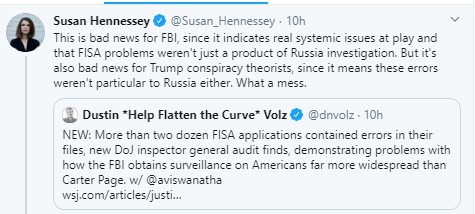
On March 31, Inspector General Michael Horowitz released an interim report on his audit of the Federal Bureau of Investigation’s compliance with procedures to protect Americans’ civil rights in Foreign Intelligence Surveillance Act cases. Horowitz’s “Management Advisory Memorandum” detailed devasting and systematic failures by the FBI in executing the procedures designed to ensure the accuracy of the applications submitted under oath to the FISA court.
Contrary to the left’s spin, the FBI’s incompetence in handling more (Most? All?) FISA cases is not a vindication of the Crossfire Hurricane team that illegally surveilled Carter Page and, in turn, the Donald Trump campaign.
Ignoring Rules Designed to Preserve Accuracy
Horowitz’s memorandum opened by noting that the report he issued in December 2019 concerning the four Page FISA applications, detailed “among other things,” “fundamental and serious errors in the agents’ conduct of the FBI’s factual accuracy review procedures (‘Woods Procedures’) with regard to all four FISA applications.” The FBI’s failure to comply with the Woods Procedures in the Page FISA applications prompted the IG’s office to “initiate an audit to examine more broadly the FBI’s execution of, and compliance with, its Woods Procedures.”
The Woods Procedures, Horowitz explained, were implemented “in 2001 following errors in numerous FISA applications submitted to the FISC in FBI counterterrorism investigations.” Those procedures sought to “minimize factual inaccuracies in FISA applications and to ensure that statements contained in applications are ‘scrupulously accurate.’”
As part of the procedures, the FBI required a case agent requesting a FISA application to create a “Woods File” that included: “(1) supporting documentation for every factual assertion contained in a FISA application, and (2) supporting documentation and the results of required database searches and other verifications.” Prior to seeking a FISA surveillance order, both the case agent and a supervisory special agent were required to verify that the Woods File contained “supporting documentation for every factual assertion within the FISA application.”
In auditing the FBI’s compliance with the Woods Procedures, Horowitz’s team focused on FISA surveillance orders issued from October 2014 to September 2019. As part of the audit, Horowitz’s team visited eight FBI field offices and selected, from more than 700 applications, “a sample of 29 applications relating to U.S. Persons involving both counterintelligence and counterterrorism investigations.”
What Horowitz discovered seems to have shocked even him, as he issued yesterday’s memorandum and “preliminary” findings while the audit remains ongoing. Bottom line: “We do not have confidence that the FBI has executed its Woods Procedures in compliance with FBI policy,” Horowitz wrote.
Constant and Widespread Errors
But the devil is in the details, such as that the IG’s office “could not review original Woods Files for 4 of the 29 selected FISA applications because the FBI has not been able to locate them and, in 3 of these instances, did not know if they ever existed.” Of the 25 files they were able to review, there were “errors or inadequately supported facts in all of the 25 applications” (emphasis added).
Those errors included “facts stated in the FISA application that were: (a) not supported by any documentation in the Woods File, (b) not clearly corroborated by the supporting documentation in the Woods File, or (c) inconsistent with the supporting documentation in the Woods File.” While Horowitz noted the review was ongoing, his team had already “identified on average of about 20 issues per application,” with one application actually having 65 issues.
The IG memorandum also noted that about half of the files reviewed contained facts attributed to Confidential Human Sources, or CHSs, but many of those files, in violation of the Woods Procedures, failed to include a statement from the handling agent regarding the CHS’s reliability and background and the accuracy of the information derived from the CHS. The FBI likewise violated the Woods Procedures’ mandate that case agents re-verify the facts contained in renewal applications. That was not consistently done, and in some instances the case agents stated they “only verified newly added statements of facts.”
A Mockery of Pretended Oversight
Another outrageous revelation concerned the supposed “oversight mechanisms” instituted to ensure compliance with the Woods Procedures. One “check” involves the FBI’s chief division counsel (CDC) at each FBI field office to perform an accuracy review of at least one FISA application. The Department of Justice’s National Security Division (NSD) must also conduct “its own accuracy review each year of at least 1 FISA application originating from each of approximately 25 to 30 different field offices.”
But, as Horowitz explained, in conducting the “accuracy review,” the FBI’s CDC and the DOJ’s NSD don’t review the Woods Files as created. No, instead they provide the FBI field offices advance notice of the specific FISA application they intend to review and then allow the FBI agents time to compile any documentation necessary to support the FISA application.
Even then, the “accuracy reviews” uncovered about 390 issues in 42 FISA applications, including “unverified, inaccurate, or inadequately supported facts, as well as typographical errors.” FBI headquarters, however, failed to use the “accuracy reviews” “in a comprehensive, strategic fashion” to “help assess the FBI’s compliance with its Woods Procedures.”
After highlighting these many deficiencies, Horowitz stressed that he would provide the FBI more details concerning the issues his team discovers in the various FISA applications at the completion of the audit. But in the meantime, Horowitz shared a few preliminary recommendations, such as assuring a Woods file actually exists for all pending and current FISA cases.
Will This Be a Final Straw for Congress?
Yesterday’s recommendations come on top of the many recommendations Horowitz made last year when he released his 400-page report on the FISA abuse that targeted Page. But while this is bad news for the FBI (and Americans and civil liberties), the anti-Trump Russian collusion hoaxers found a favorable spin: “See, this isn’t about Trump, the FBI fudges all their FISA surveillance applications.”

That’s quite the goalpost shift from the left’s earlier narrative that “FISA surveillance orders are extremely difficult to obtain.” (It’s also quite the indictment of the resistance’s hero James Comey, who served as FBI director during the majority of the time period under audit.)
This spin doesn’t fly, either. Horowitz’s Tuesday memorandum focused on procedure only and the question of whether the FBI had complied with the Woods Procedures. Horowitz expressly stated, more than once, that the IG’s office did not make any “materiality judgements” and did not “confirm FISA application accuracy or identify any relevant omissions.” Horowitz also did “not speculate as to whether the potential errors would have influenced the decision to file the application or the FISC’s decision to approve the FISA application.”
Conversely, the IG found the Page FISA surveillance applications contained 17 significant inaccuracies and omissions—18 if you include the one the IG missed. Also, the government has already conceded that material errors in two of the four FISA applications made those court surveillance orders invalid.
That the FBI was systematically sloppy in compiling the Woods files for other FISA applications says nothing about the anti-Trump motives and misconduct involved in the Page FISA applications. We’re not talking about procedures there. We’re talking altering emails and lying to the FISA court about Page’s cooperation with the CIA; we’re talking about using an unverified, Hillary Clinton-funded, salacious dossier to feign probable cause; we’re talking about an “insurance policy,” an unnamed and unknown sub-sub-sources; we’re talking about a dozen other significant errors and omissions; and we’re talking about stopping that man from getting elected.









